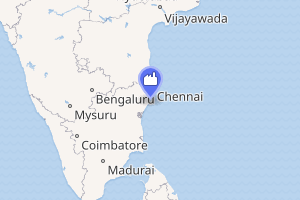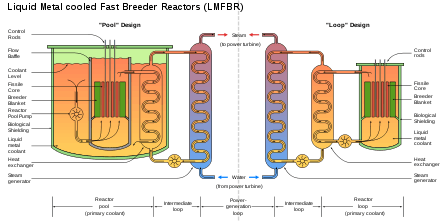Prototype Fast Breeder Reactor
The Prototype Fast Breeder Reactor (PFBR) is a 500 MWe fast breeder nuclear reactor presently being constructed at the Madras Atomic Power Station in Kalpakkam, India.[1] The Indira Gandhi Centre for Atomic Research (IGCAR) is responsible for the design of this reactor. The facility builds on the decades of experience gained from operating the lower power Fast Breeder Test Reactor (FBTR). Originally planned to be commissioned in 2012, the construction of the reactor suffered from multiple delays. As of August 2020, criticality is planned to be achieved in 2021.[2]
| Prototype Fast Breeder Reactor | |
|---|---|

| |
| Country | India |
| Location | Madras |
| Coordinates | 12°33′11″N 80°10′24″E |
| Status | Under construction |
| Construction began | 2004 |
| Construction cost | ₹5,677 crore (US$795.92 million) |
| Owner(s) | BHAVINI |
| Operator(s) | BHAVINI |
| Nuclear power station | |
| Reactor type | fast breeder |
| Cooling source | |
| Power generation | |
| Nameplate capacity | 500 MW |
History
In 2007 the reactor was planned to begin operating in 2010, but as of 2019 it is expected to reach first criticality in 2020.[2] The Kalpakkam PFBR is designed to use uranium-238 to breed plutonium in a sodium-cooled fast reactor design. The power island of this project is being engineered by Bharat Heavy Electricals Limited, largest power equipment utility of India.
The surplus plutonium (or uranium-233 for thorium reactors) from each fast reactor can be used to set up more such reactors and grow the nuclear capacity in tune with India's needs for power. The PFBR is part of the three-stage nuclear power program.
India has the capability to use thorium cycle based processes to extract nuclear fuel. This is of special significance to the Indian nuclear power generation strategy as India has one of the world's largest reserves of thorium, which could provide power for more than 10,000 years,[3] and perhaps as long as 60,000 years.[4][5]
The design of this reactor was started in the 1980s, as a prototype for a 600 MW FBR. Construction of the first two FBR are planned at Kalpakkam, after a year of successful operation of the PFBR. Other four FBR are planned to follow beyond 2030, at sites to be defined.[6]
In July 2017, it was reported that the reactor is in final preparation to go critical.[7] However in September 2018, it was reported that the reactor might go critical only in 2019.[8]
Technical details

The reactor is a pool-type reactor with 1,750 tonnes of sodium as coolant. Designed to generate 500 MWe of electrical power, with an operational life of 40 years, it will burn a mixed uranium-plutonium MOX fuel, a mixture of PuO
2 and UO
2. A fuel burnup of 100 GWd/t is expected. The Advanced Fuel Fabrication Facility (AFFF), under the direction of BARC, Tarapur, is responsible for the fuel rods manufacturing. AFFF comes under " Nuclear Recycle Board" of Bhabha Atomic Research Center. AFFF has been responsible for fuel rod manufacturing of various types in the past.
Safety considerations
The prototype fast breeder reactor has a negative void coefficient, thus ensuring a high level of passive nuclear safety. This means that when the reactor overheats (below the boiling point of sodium) the speed of the fission chain reaction decreases, lowering the power level and the temperature.[9] Similarly, before such a potential positive void condition may form from a complete loss of coolant accident, sufficient coolant flow rates are made possible by the use of conventional pump inertia, alongside multiple inlet-perforations, to prevent the possible accident scenario of a single blockage halting coolant flow.[10] The active-safety reactor decay heat removal system consists of four independent coolant circuits of 8MWt capacity each.[11] Further active defenses against the positive feedback possibility include two independent SCRAM shutdown systems, designed to shut the fission reactions down effectively within a second, with the remaining decay heat then needing to be cooled for a number of hours by the 4 independent circuits.
The fact that the PFBR is cooled by liquid sodium creates additional safety requirements to isolate the coolant from the environment, especially in a loss of coolant accident scenario, since sodium explodes if it comes into contact with water and burns when in contact with air. This latter event occurred in the Monju reactor in Japan in 1995. Another consideration with the use of sodium as a coolant is the absorption of neutrons to generate the radioactive isotope 24
Na, which has a 15-hour half life.[12]
See also
- India's three stage nuclear power programme
References
- Baldev Raj, S.C. Chetal and P. Chellapandi (8 January 2010). "Great expectations". Nuclear Engineering International.
- "Indian government takes steps to get nuclear back on track". world nuclear news. World Nuclear Association. 11 February 2019.
- Chris Rhodes (26 February 2012). "Thorium can power civilization for over 3000 years". Retrieved 23 March 2012.
- MacKay, David J. C. (20 February 2009). Sustainable Energy - Without the Hot Air. UIT Cambridge Ltd. p. 166. Retrieved 2012-03-23.
- Rodricks, Dan (9 May 2011). "Thor's nuclear-powered hammer". The Baltimore Sun. Retrieved 23 March 2012.
- "India plans to construct six more fast breeder reactors". The Economic Times. 1 December 2015. Retrieved 15 December 2015.
- "Nuclear reactor at Kalpakkam: World's envy, India's pride". The Times of India. 2017-11-26. Retrieved 2 July 2017.
- "Kalpakkam fast breeder reactor may achieve criticality in 2019". The Times of India. Press Trust of India. 20 September 2018.
- Raj, Baldev (30 October 2009). "Design Robustness and Safety Adequacy of India's Fast Breeder Reactor". Science & Global Security. 17 (2–3): 194–196. doi:10.1080/08929880903451397.
- Raj, Baldev (30 October 2009). "Design Robustness and Safety Adequacy of India's Fast Breeder Reactor". Science & Global Security. 17 (2–3): 194–196. doi:10.1080/08929880903451397.
- "Design of 500 MWe Prototype Fast Breeder Reactor" (PDF). Archived from the original (PDF) on 2012-04-17. Retrieved 2012-04-17.
- Busse, J.G. (April 1978). "Slow breeder makes its own nuclear fuel". Popular Science. 212 (4). pp. 89–91, 200, 202.
External links
- "Kalpakkam PFBR to be completed ahead of schedule; 4 more to come up by 2020". The Hindu. 7 September 2005.
- The design of the Prototype Fast Breeder Reactor, Nuclear Engineering and Design, April 2006